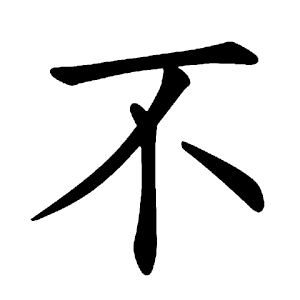不
- not, no;
Etymology
The exact origin of 不 is uncertain. The earliest oracle bone forms show a shape with three prongs pointing downward, sometimes with a horizontal stroke (一) on top.
Shuowen Jiezi (説文解字 shuōwén jiězì): describes it as a bird flying upward and not descending — interpreted as “not returning,” hence “not.”
Other theories:
• flower calyx (柎의 본자);
• plant root representation.
Over time, the meaning “not” became dominant.
Usage in Korean
It is one of the most basic and frequently used negation characters in Classical and Modern Chinese, as well as in Korean and Japanese.
不 is part of a family of negative characters with slightly different nuances:
無 – “not, none, does not exist” (absolute absence, like no / none);
未 – “not yet” (temporal negation, e.g. 未來 “future” = not yet come);
弗 – originally “not,” but rarely used now except in words like 弗 (dollar) or 불소 (fluoride);
非 – “wrong / not in accordance with” (denial of category or quality; implies wrongness);
否 – “to refuse, to reject” (used when actively saying “no” or recording rejection, e.g. 가/부 표 in voting).
Words that derived from 不
- 과부족(過不足)–excess and deficiency
- 꼴불견(꼴不見)–shabbiness; indecency; ugly scene
- 부단히(不斷히)–continuously; ceaselessly; constantly
- 부도덕(不道德)–being immoral; being unethical
- 부동(不動)–being immovable; being immobile; being unshakable; being unchallenged
- 부정부패(不正腐敗)–corruption
- 부족(不足)–shortage; lack
- 부족하다(不足하다)–insufficient; inadequate
- 불가(不可)–wrong; impossibility
- 불가결(不可缺)–indispensability
- 불과(不過)–only
- 불리(不利)–disadvantage
- 불리하다(不利하다)–disadvantageous
- 불만(不滿)–dissatisfaction
- 불만족(不滿足)–dissatisfaction
- 불명(不明)–being unknown; indecent behavior
- 불변(不變)–invariability; unchangeability
- 불신(不信)–distrust
- 불안(不安)–uneasiness; anxiety; uncertainty; insecurity
- 불의(不義)–injustice; unrighteousness
- 불이익(不利益)–disadvantage; penalty; detriment
- 불편(不便)–inconvenience; discomfort; awkwardness
- 불편하다(不便하다)–inconvenient; uncomfortable; awkward
- 불합리(不合理)–being unreasonable; being illogical
- 불행(不幸)–unhappiness; misery; difficulty
- 신토불이(身土不二)–belief that domestic farm products are the best
- 정체불명(正體不明)–being mysterious; being unidentified
- 철부지(철不知)–child; immature person
- 一火 (MF)
- ⿸ 丆 ⿰ 丨 丶 (G H J K T)
- ⿻ 丆 卜 (V)
